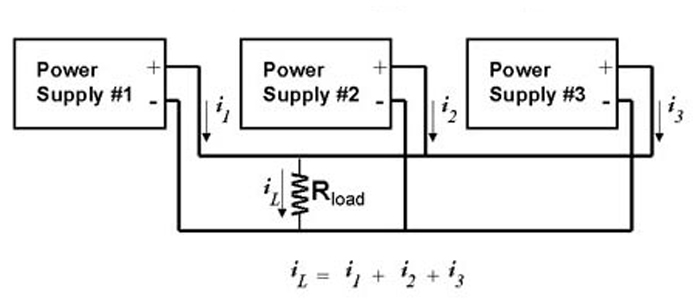What is Parallel Forced Sharing?
Parallel forced sharing is a method of paralleling power supplies and using their combined current to generate a feedback signal that adjusts the each of the power supply’s output accordingly.
Power supplies are paralleled for a variety of reasons, these include increasing current to the load, increase redundancy, reliability and efficiency, or when it is required to derate power supplies. The effective current becomes the summation of the individual currents from each of the supplies. The parallel does not increase the current that a load takes; instead, it ensures that the load gets all the current it requires.
Parallel power supply units – Image Credit
Two switch mode power supplies with feedback loops will do strange and sometimes unexpected things when connected in parallel. Often one supply will carry the entire load until its current limit is reached. If it starts hiccupping before the other one comes to its rescue the two supplies may start a chaotic oscillation.
In the parallel forced sharing, the power supply units are made to communicate with each other so they can collaborate. Sometimes this takes the form of a master-slave operation, and sometimes they just force each other to put out the same current.
To ensure efficient and stable operation, where the load is shared proportionally without straining some of the power supplies, it is important to use an appropriate current sharing method. The parallel sharing does not increase the voltage. The output voltage is usually the same for all the power supply units.
How the parallel forced sharing works
The forced current sharing uses an active circuit to measure and compare the current outputs from the paralleled power supplies. A parallel external communication link usually referred to as the third wire is used to connect the power supplies together. This carries the summed compensation signal that is applied to each of the parallel power supply.
The active circuit provides a feedback signal to the converter’s pulse width modulator which causes the individual converter to adjust and vary the output voltage and current sharing ratios of the converters.
Advantages of parallel forced sharing
- No need for adjustments
- Good voltage regulation within +/- 1%
- Sharing the load evenly
- Good scalability
Disadvantages of parallel forced sharing
- More complex
- Expensive
- Requires similar power supply models and may not work with different models from the same manufacturer or with power supplies from different manufacturers
- Requires a circuit to reduce external noise on the third wire and avoid stray voltages from getting into the load.
- Care should be taken not to exceed the impedance of the parallel connection by sticking to the recommended number of parallel units, hence a limited number of units that can be paralleled.
